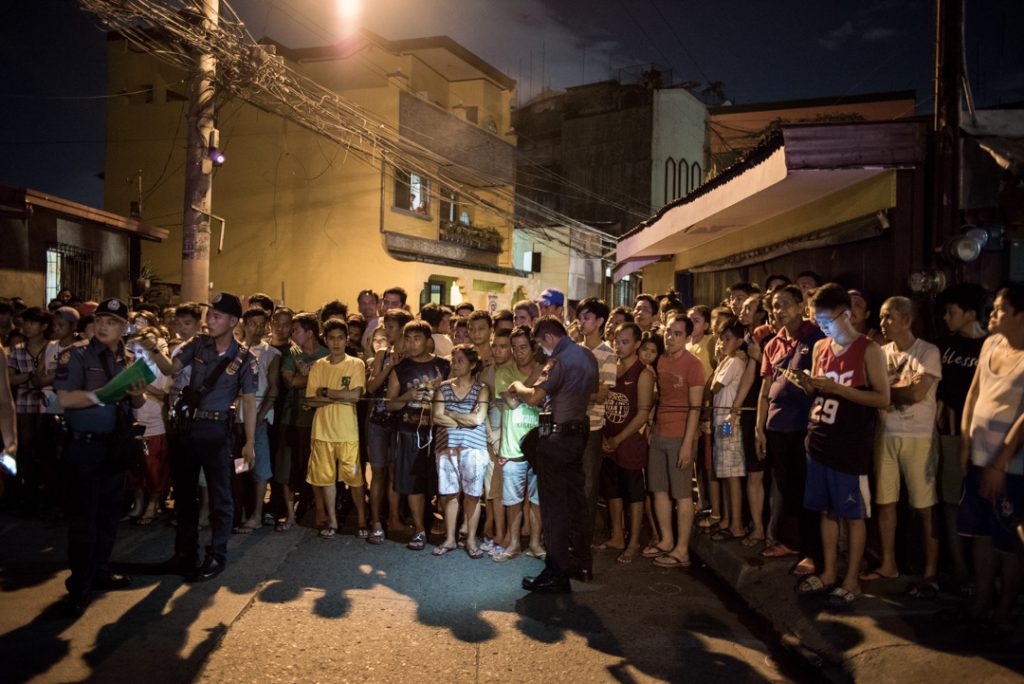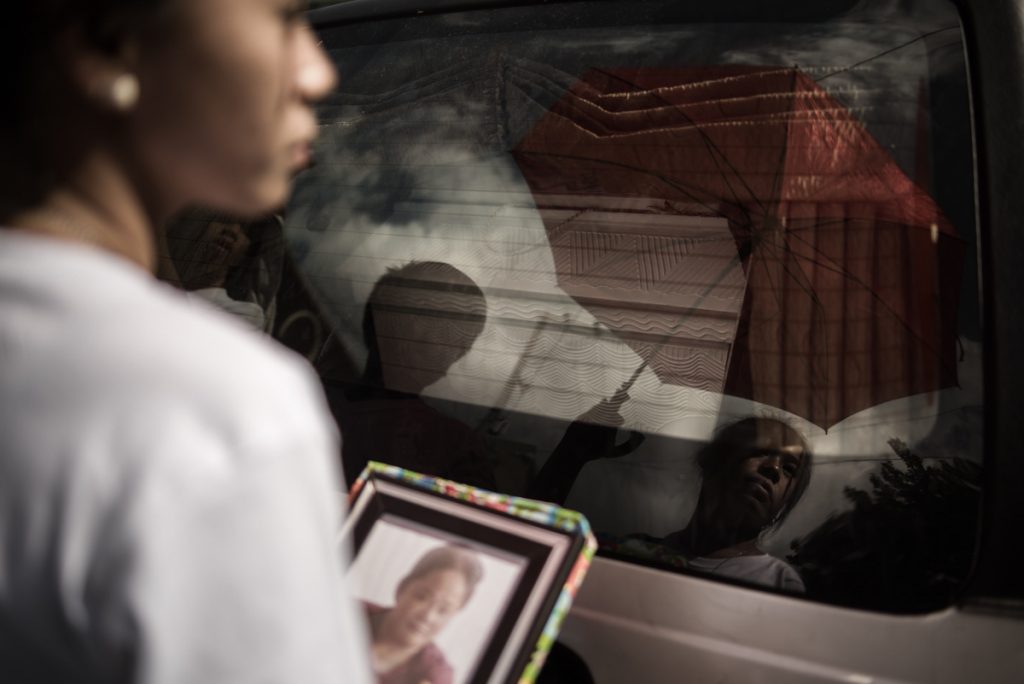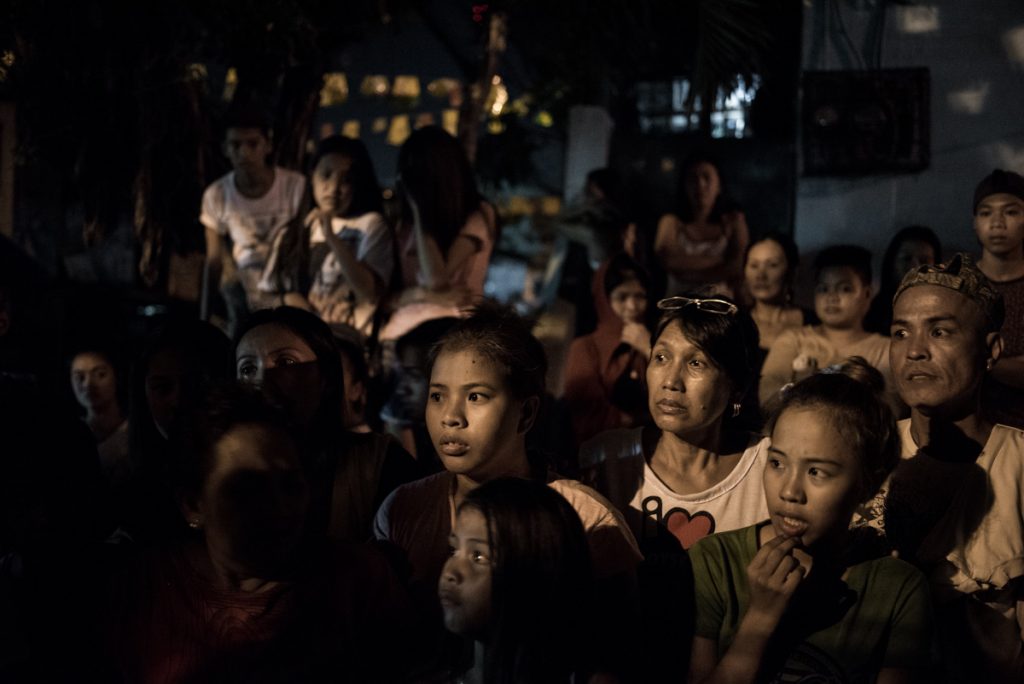Jay Ramirez writes about Carlo Gabuco’s visceral, intimate and poignant depictions of Duterte’s ‘war on drugs’ in the Philippines. Some brilliant insights on the power of art that bring the concept of human rights “down to the gut.”
In an art fair in Manila in March last year, one installation caught everybody’s eye.
A blue single-seater armchair sits in the middle of a darkened room. It is surrounded by lamps hanging from the ceiling and rotating; another lamp hangs directly above it. The voice of a young girl named Christine, whose fleeting image is projected on a wall, tells the story of how her father knelt in front of the police before he was shot right in front of her.
Before spectators can fully understand what was happening, they get up to realise that the chair they have been sitting on has a bullet hole in it. And just behind it, a bullet wrapped in clear plastic is pinned to the wall – the bullet that killed Christine’s father.
“It’s really happening, isn’t it?” one spectator tells Carlo Gabuco, the artist who made the installation, as she turns to see a wall covered with hundreds of photos of killings, mourning and funerals from the country’s ‘war on drugs’.
The installation is aptly titled ‘Those Without Names’, a phrase borrowed from a poem of Pete Lacaba, a renowned Filipino poet, film-maker and journalist. The title could very well describe the thousands of victims of alleged extrajudicial killings in the country who have become faceless and nameless statistics: more than 20,000 since President Rodrigo Duterte assumed office in July 2016, according to human rights groups; only a handful of unfortunate mistakes according to government officials, who insist that most of the more than 5,000 people who have died in the ‘war on drugs’ all resisted arrest and died during legitimate police operations.
Responses to the work on social media testify to its power. “One of the most memorable galleries in this year’s Art Fair,” wrote one Instagram user. “Probably one of the best and striking stand-alone exhibits I’ve seen,“ wrote another. “Pretty overwhelming at first (especially for me going to the Art Fair for the first time) yet these simply moved me to better understand what lies on the aftermath of the present administration’s war on drugs in the communities of Metro Manila.”
The artist
Carlo Gabuco is a 38-year-old visual artist and photographer. “I want people to experience it, I want people to realise it,” he says, to the extent of borrowing the very chair on which Christine’s father died to drive home the point. But he does not want to preach:
“I don’t like the idea that you dictate how people look at the work. It has to be an experience. It has to be them who realise it. That’s where the power of the artwork lies.
“The people who were able to realise it, I saw them crying,” he continues. “They were in shock. And when they realised that it was the actual couch [chair], they would ask us just to make sure: ‘Is that the actual couch where her father died?’ Then we tell them, ‘Yes.’”
At the time of the art fair, Gabuco had been documenting the killings for close to two years, working with local and foreign media organisations. He said the seeming apathy of the public towards the thousands killed drove him to create the installation as well as to pursue other projects that highlight the effects of the brutal campaign against drugs.
It started almost as a gut feeling. A painter by training, Gabuco’s paintings had mostly been violent – one, for instance, showed a bloodied man, his face to the ground as a shoe treads on the back of his head – so the impulse to document the killings came quickly when he began seeing his friends post photos of them on social media.
“I asked myself, ‘What am I doing here?’ I was just inside a studio. I had been doing this [working on violent images] before and yet I was still bothered by the images I saw,” he says. “My friends would post pictures every day. I would see the dates. It’s happening every night, every day.”
He went on to shoot photos of the drug war almost every night, not understanding at first what was happening. Once he realised the magnitude of the problem, he kept shooting. And those photos wound up in the installation.




‘Less than human’ series.
Photos: Carlo Gabuco. All rights reserved.
The human rights organisations
It is with art like Gabuco’s that human rights groups are hoping to break the strong public support for the war on drugs. Surveys show that public satisfaction with the policy has ranged from more than 90% in 2017 to 78% in 2018, even though in late 2018 more than 60% believed police were involved in extrajudicial killings.
Even more challenging for Filipino human rights advocates, the constant tirades against human rights groups by Duterte himself have led to human rights work being vilified and advocates accused of siding with drug suspects. “Your concern is human rights. Mine is human lives,” the president once said – although he has also threatened to kill and behead human rights advocates several times.
At the receiving end of such criticism is the Philippine Commission on Human Rights, whose chair Chito Gascon has been accused of siding with the previous ruling party.
“When the credibility of the Commission on Human Rights is attacked, that affects the work that we do,” says Angie Umbac, the commission’s advocacy officer. She explains that many members of the public have resisted conventional discussions and campaigns on human rights.
Hence the need to find other avenues to reach out to the public. The Commission on Human Rights has turned to working with artists who can promote human rights issues without the hostile reaction. The commission has provided support, for, instance to ‘Tao Po’ (the phrase means ‘Anybody home?’ but can also be translated ‘Human here’), a monologue featuring different characters and how they deal with the war on drugs.
Human rights can no longer be taught using big words, abstract ideas, PowerPoint presentations and lectures. “The concept of human rights has to be brought down to the gut.”
Angie Umbac

The commission has also supported a community theatre group comprising families of people killed in the war on drugs and a group of photojournalists who document the killings. It is also sponsoring video-making and song-writing contests.
“The work of artists is effective,” Umbac says. “They have a reach bigger than the human rights community. They’re able to go into areas where we are not present. The approach is accessible to the public, noting that people are better able to empathise with artists and their work. It becomes very real to them.”
More broadly, the commission knows that human rights can no longer be taught using big words, abstract ideas, PowerPoint presentations and lectures. “The concept of human rights has to be brought down to the gut,” says Umbac.
It’s not just Philippine-based groups who are taking the artistic route. International organisations like The Fund for Global Human Rights, which has been providing support to local human rights groups in more than 25 countries for the past 16 years, recently launched a New Actors’ Fund that supports different types of activists, not necessarily linked to human rights groups – such as artists.
“The work of artists is effective. They have a reach bigger than the human rights community. They’re able to go into areas where we are not present. The approach is accessible to the public, noting that people are better able to empathise with artists and their work. It becomes very real to them.”
Angie Umbac
Among the groups the fund is supporting are a street theatre of the oppressed in Morocco that deals with violence against women and a group of sex workers in India who put up comedic performances about their work to break down social barriers.
“Art is like a shortcut to your emotions,” says Marianne Mollmann, director of regional programmes at the fund. “I call it human rights but other people might just call it the conditions for living, like what I need to stay alive. And that is a profoundly emotional thing.”
Mollmann cites Gabuco’s art installation as an example of an effective approach to changing minds through an artist’s work. “Maybe it will make you think a little differently the next time you read a story in the paper about a drug addict or a drug dealer who was killed,” she says. “You might think, ‘I wonder if he had a kid. Was there a kid left behind?’ You think about the implications.”

‘Less than human’ series.
Photo: Carlo Gabuco. All rights reserved.
‘Less than human’ series.
Photo: Carlo Gabuco. All rights reserved.
But she acknowledges that while artists’ works might have an immediate impact on those who see them, converting that emotional reaction to a change in public opinion in the long term remains a big challenge.
“How do you make sure that the people who see that artist’s work, the people who are actually convinced, ‘Oh, something’s terribly wrong, I need to do something about this’ – where do they then go?” she says, emphasising the need for donors to connect artists to local human rights groups to complement the artistic approach and sustain its effects.
“Sometimes we’ve started playing this role of connecting the artist with the local group, or connecting the local group with the artist so that there is this complementarity in the work,” she adds.
But while Gabuco hopes for social change, he is uncomfortable with the idea that he is changing the world. Changing public opinion is a long-term job – what he does is to engage the public one artwork at a time.
“I don’t think it will happen through my pictures,” he says. “But I want to add to the discussion.”
This article by Jay Ramirez (pseudonym) was originally published on openDemocracy.net under a Creative Commons Licence.
Top featured image: ‘Less than human’ series. Carlo Gabuco. All rights reserved.